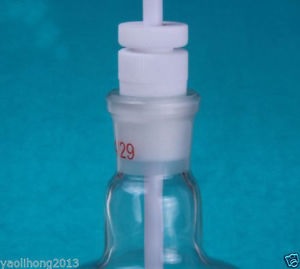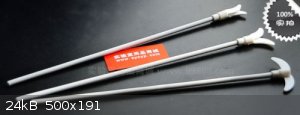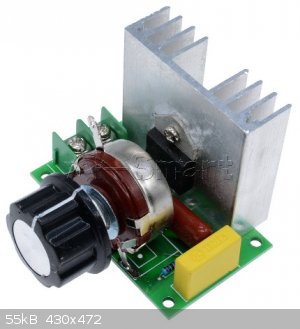CobaltChloride
Hazard to Others
  
Posts: 239
Registered: 3-3-2018
Location: Romania
Member Is Offline
|
|
How to select a good hotplate stirrer?
I'm finally prepared to invest in a hotplate stirrer. Everything in my country has enormous prices (about 250$ is the best I found) so I decided to
look on ebay. Is any of these hotplates good?
https://www.ebay.com/itm/220V-50Hz-Magnetic-Stirrer-Dual-Con...
https://www.ebay.com/itm/2000ml-Hot-Plate-Magnetic-Stirrer-D...
https://www.ebay.com/itm/1000ml-Magnetic-Stirrer-With-Hot-Pl...
They have heating powers raging from 150W-200W. Is that enough? My current non-stirring hotplate has 500W (or that's what it says on the box, but it
may be a lie considering it was about 7 euros) and it takes quite a while to get 250 ml of water boiling and even then it evaporates very slowly. Is
this enough? Also, how long do these Chinese hotplate stirrers last? NurdRage's broke quite quickly.
If these hotplate stirrers aren't good, could you point me to one that is good, lasts at least 2-3 years of use, costs less than 100$ and can be
shipped to Romania?
[Edited on 6-5-2018 by CobaltChloride]
|
|
|
CobaltChloride
Hazard to Others
  
Posts: 239
Registered: 3-3-2018
Location: Romania
Member Is Offline
|
|
At first, I was tempted to combine my stirrer (basically a 120mm computer fan with a few magnets glued to it) with my hotplate, but I had problems
because the heating element was very magnetic. Maybe someone could help me find a suitable heating element and make a hotplate stirrer by myself. I
don't have any practical experience with electronics (except making computers from components and repairing some computer parts, but this is
unrelated), but I know what should be done theoretically speaking.
|
|
|
JJay
International Hazard
    
Posts: 3440
Registered: 15-10-2015
Member Is Offline
|
|
Make sure the hotplate is powerful. I have a 300 watt 85-2, and it can't boil a liter of water in a beaker. I would not even consider buying a
180-watt hotplate. My 560-watt Corning PC-320 can boil 10 liters on full power if I give it some time to heat up. It doesn't do fine temperature
control, but if I have other means for that.
I would only buy a temperature controlled hotplate if it is high wattage, preferably with a ceramic top. It is going to be hard to find a usable one
for less than $700-800, and that won't be a high-end model.
|
|
|
CobaltChloride
Hazard to Others
  
Posts: 239
Registered: 3-3-2018
Location: Romania
Member Is Offline
|
|
Ok. So those weak hotplates are out of the question. Is this one good? https://www.ebay.com/itm/New-Magnetic-Stirrer-with-Heating-P... . It says that it has 350W power, which should be enough considering I want, at
most, to heat about 700ml of liquid while also stirring it. I'm afraid it might be of poor quality considering that you said a usable one is at least
700$. I'm not really interested in it having either a ceramic top, nor precise temperature control (this one does, but I wouldn't mind buying one
without it).
Did anybody buy the hotplate I linked to? If so, how long did it last?
|
|
|
JJay
International Hazard
    
Posts: 3440
Registered: 15-10-2015
Member Is Offline
|
|
I have an 85-2 (300 watts though, or at least that is what was claimed), and while I do use it for some things, it can barely boil 100 mL of water. It
has temperature control, but the maximum temperature is 100 C. It might be fine for biologists or brewers, and I use mine from time to time for things
like stirring and temperature control on electrolytic cells, but on its own, it is really not sufficient for most purposes that I would like to use it
for.
|
|
|
CobaltChloride
Hazard to Others
  
Posts: 239
Registered: 3-3-2018
Location: Romania
Member Is Offline
|
|
Oh. So it seems that the only option left for me is trying to make one.
|
|
|
VSEPR_VOID
National Hazard
   
Posts: 719
Registered: 1-9-2017
Member Is Offline
Mood: Fullerenes
|
|
I got more use out of a Walmart hotplate than I did out of the hotplate/stir I purchased from HST. Sometimes it is best to go cheap. Have you
considered making an overhead stir?
Within cells interlinked
Within cells interlinked
Within cells interlinked
|
|
|
Sulaiman
International Hazard
    
Posts: 3558
Registered: 8-2-2015
Location: 3rd rock from the sun
Member Is Offline
|
|
An alternative :
I had a cheap 1500W hotpate that I eventually killed
and now I have a second-hand dual 1500W & 500W hotplate

which of course is incompatible with a magnetic stirrer,
so I constructed an overhead stirrer with a motor and these from eBay
 
==============================================
I also made a heating mantle using one of these https://www.ebay.co.uk/itm/500ML-250W-Hand-Woven-Adjustable-...
a cake tin and one of these

==============================================
I am of the opinion that RBFs in a heating mantle can do everything that can be done on a hotplate,
with far less stress on the glassware,
so I suggest that you do not bother with beakers and flat-bottomed flasks and use RBFs instead.
CAUTION : Hobby Chemist, not Professional or even Amateur
|
|
|
CobaltChloride
Hazard to Others
  
Posts: 239
Registered: 3-3-2018
Location: Romania
Member Is Offline
|
|
I thought of that, but there's the problem of cleaning them. It is much harder to clean an RBF than a beaker. Also, thanks for the overhead stirrer
idea! I thought they were only made in sizes suited for huge reaction flasks. Sorry if this is too much of a spoon-feeding request, but what is that
thing you use to make an air-tight seal between the stirrer and the flask? I'm not at all familiar with overhead stirrers. Also, could you specify a
bit more about your overhead stirrer design, please? What is the power of the motor and how much liquid can it stir?
|
|
|
JJay
International Hazard
    
Posts: 3440
Registered: 15-10-2015
Member Is Offline
|
|
If you're concerned that RBFs are hard to clean, you could always use a reactor with a removable head, but they are pretty pricey. I've managed to
clean every dirty RBF I've run into so far.
[Edited on 6-5-2018 by JJay]
|
|
|
DavidJR
National Hazard
   
Posts: 908
Registered: 1-1-2018
Location: Scotland
Member Is Offline
Mood: Tired
|
|
My hotplate is 750W at the maximum power setting (as measured by myself, not just read off of product specs). This is plenty powerful:
I tried to dry a dessicant (CaCl2 IIRC) by putting it in a disposable aluminium foil dish on the hotplate, which I set to full power to
heat up with the intention of turning it down once it was hot. Well.... I got distracted for a couple of minutes and when I came back there was a pool
of molten aluminium. Just as well the top of the hotplate is ceramic rather than aluminium itself.
In a strikingly similar incident, where I was attempting to dry molecular sieves 3A, I destroyed a flask. The technique (which I have used
successfully several times) was to put a layer of the sieves into a large erlenmeyer flask, connected to the vacuum pump, and heat this on the
hotplate. Handy tip: if you put the outlet hose from your vacuum pump into a beaker of water, you can tell when the sieves are completely dry when the
bubbling stops. Anyway, I again set the hotplate to full power to heat it up quickly with the intention of turning it down, but got distracted for
really only a few minutes before coming back to it. Well, I tried to pick the flask off the hotplate but it was stuck to the surface. Then I noticed
that the bottom of the flask was glowing a dull red. So, I aborted, turned off the hotplate and pump. When it cooled, I pried off the flask. The
entire bottom of the flask had caved in under the vacuum.
Additionally I've distilled azeotropic sulphuric acid with this hotplate, just using a round bottom flask sat atop the hotplate, and some aluminium
foil as a skirt to keep hot air in.
So, getting back to the subject: 750W is more than enough power for everything you'd want a lab hotplate to do, in my opinion. I certainly wouldn't
buy a 200W one.
|
|
|